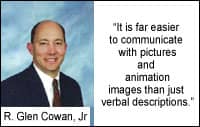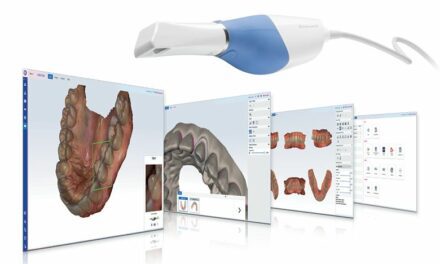by Anita D’Alessandro
Five orthodontists compare notes on the hardware and software that power their practices
|
Q: What sort of computer hardware do you use?

Cowan: We have a network of five workstations, plus one laptop that can be moved as needed.
Depew: I personally use a tablet PC. We have laser printers for reports, appointment tickets, schedules, and nongraphical letters. We also have printers that make excellent-quality printouts of photos, x-rays, and letters containing graphics. We also have a digital imaging system for x-rays and photographs. We have a touch-screen monitor for patient check-in.
Enoch: We use UNIX PCs.
Yanosky: We have several types of hardware in the office, depending on when replacement has been needed. These range from flat-panel monitors to traditional monitors, laptop computers, and tablet PCs.
Q: Do you have chairside computers?
Berman: Yes, seven, as well as three at the front desk (one for patient sign-in), one in the x-ray room, one in the records room, one in the consultation/exam room, and a couple others for administrative purposes and support.
Cowan: We do not have fixed chairside computers. The exception is a laptop that can be used at chairside if needed. This laptop is mainly used for patient communication via an animation program.
Depew: Yes. We have a notebook computer at each chair in the treatment bay. I like their compact nature and portability (if needed). I just couldn’t see having the cables, keyboard, mouse, CPU, and monitor that would be needed for a desktop machine working at the treatment chairs. Using a touch pad on the notebook instead of a mouse was a bit of a challenge for the assistants at first. But they got used to it quickly.
Enoch: No.
Yanosky: Yes, we have chairside computers/monitors.
Q: If you’ve upgraded recently, how much more efficient is your practice now than before the upgrade?
Berman: We recently acquired a charting module to eliminate the use of charts, but we have not implemented it yet. But that should completely eliminate the need for pulling charts each day, and make finding patient information quicker when needing to discuss a patient over the phone. However, when we started with a digital x-ray machine and chairside computers (about 18 months ago), things really improved. Additionally, the ability to send radiographs and photos by e-mail at a moment’s notice has made communication with parents, patients, and doctors much more efficient.
Cowan: We have not had a major upgrade in the last 12 months.
Depew: We upgraded {our practice-management software] last year. I wouldn’t necessarily say that it has made us more efficient overall. The older system responded to commands faster. It hasn’t made it so we can see more patients or work with less staff members. One area, though, that has proven helpful is the electronic charting. We no longer have to pull charts every day, and spend time filling them out. Unfortunately, we spend way too much time fixing software glitches.
Yanosky: We have upgraded where we have needed to. As we are collecting more and more images and smile-animation videos, we have needed to upgrade our image server. The increased speed with which images can be viewed chairside does improve efficiency. In the future, we will certainly upgrade monitors/computers, etc. While it may not necessarily improve efficiency, it will improve our presentation to the patient, keeping our image where we want it to be.
Q: What types of software does your office use?
Berman: Orthodontic management, imaging (photos, x-rays, and tracing), word processing, browsing, emailing, 3-D digital modeling, treatment, accounting, communication/networking, and presentation.

Depew: Practice management, digital imaging (photographs and x-rays), word processing, digital models, patient education, Internet-based patient reminders and newsletters, and financial/bookkeeping.
Enoch: We use practice-management and accounting software.
Yanosky: We use practice-management software, as well as software for scheduling, patient flow, imaging, word processing (letters), electronic charting and databasing, and a program that allows us to access our office from home.
Q: What features do you find especially useful from a clinical perspective?
Berman: The imaging—having photos and x-rays always right at my fingertips, anywhere in the office.
Cowan: The digital-imaging software provides a rapid aid to diagnosis and treatment planning, as well as patient education through both orthodontic and surgical predictions. The patient-education software very quickly explains many of the common orthodontic procedures and assists the patients/parents with a quality informed consent. The use of digital records also makes it easier to seek a second opinion from a colleague.

Enoch: The scheduling program runs very smoothly, as well as the patient computer sign-in.
Yanosky: From a clinical perspective, being able to access everything (exam findings, letters, and images) chairside is very useful. Patient flow allows us to track patient-waiting time and procedure times.
Q: What features do you find especially useful from a patient-communication perspective?
Berman: Pictures are worth a thousand words, so the imaging software is the most useful for patient communication.
Cowan: The practice-management program is used to efficiently produce various letters to both the patient and referring doctors. With just a few keystrokes, any number of letters can be produced regarding cooperation, oral hygiene, patient progress, etc. Both the digital-imaging and patient-education software produce the proverbial picture that is worth a thousand words. It is far easier to communicate with pictures and animation images than just verbal descriptions. Our telephone confirmation software reminds the patients of their appointments and has dramatically reduced our number of broken appointments.
Depew: Photographs integrated with letters and before-and-after photographs help patient education by showing similar cases and their outcomes. Patient reminders—both by phone and by email—minimize no-shows.
Enoch: I actually do not care for [my current system’s] patient communication. I find it is very limiting. I know there are other programs that are nicer.
Yanosky: Having electronic charting allows us to access information about oral hygiene at previous visits, missed/cancelled appointments, and compliance very easily. This improves communication with both patients and parents by allowing us to inform them if any of these areas are becoming a limiting factor in treatment. Also, very often, orthodontists are confronted chairside by either patients or parents demanding to know why treatment has taken so long or is not progressing as desired. Without this information easily accessed, we often apologize for things that we don’t necessarily need to be apologizing for. Databasing of the exam measurements allows one entry to be used in several different communication products.
Q: What’s the most common software problem you’ve had?
Berman: Not many software problems. Occasionally, we will have corrupted files in our imaging program, and some data can be lost. Our orthodontic practice-management software occasionally needs to be closed and restarted. Once, years ago, we had a virus in our network and needed a lot of work to repair our systems. Most problems have been hardware-related, typically due to power outages that require repeated startups of servers, routers, and PCs.
Cowan: We occasionally have the routine problems where the computers will freeze or normal functions will not work. Our most serious problems, however, have occurred after loading software updates. Examples include not printing the proper number of statements or not correctly recording payments. It is now our policy to hold an update for 6–8 weeks and then contact the vendor before loading. We also tend to load these updates on nonpatient days so we have time to resolve any problems.

Enoch: The system will lock up on itself every so often.
Yanosky: Human error, of course. Actually, our system runs pretty well overall. When we update our software, we sometimes have some minor issues with the software functioning just right the day after the update, or we are just not quite accustomed to the updates.
Q: How have your computer problems been solved?

Cowan: Most of our problems have been solved via customer service with our vendors. There have been occasions when we needed a local vendor to make hardware changes. We have experienced inconsistent support, especially with “outsource” techs who do not seem to be as proficient. Communication with these techs has been difficult at times. In these situations, we generally ask for a supervisor.
Depew: Unfortunately, many of these problems are complex, require the help of support personnel, and sometimes cripple our system in the middle of a busy day. Some can be solved by a knowledgeable staff person or myself. In general, software support personnel are responsive and helpful.
Enoch: Via customer service. [Our company] is not the best at getting back to you when there has been a problem.
Yanosky: I would say 90% of the time they are solved in-house, and 10% of the time they require customer service.
Q: Are you planning to upgrade your system soon? If so, what features will you be looking for in the new system?
Berman: Since we have tried to stay current with technology, I don’t foresee updating anytime soon. But if I was looking, I would look for PCs with gigabyte cards that provide the fastest transfer of data, especially for your imaging server and the PC running your digital x-ray machine. These should be used in conjunction with gigabyte routers. I would also buy only flat-screen monitors for the space and energy savings. I also prefer the speakers to be integrated in the monitor and not be separate—again for space and energy savings.
Cowan: We are planning on updating our system. We want to move toward a paperless office with the addition of digital radiography and chairside terminals. Some key features will be vendor reputation, vendor experience, support, wireless capability, and ease of integration between imaging and practice management. I have started investigating the various systems on the market and plan on a conversion within the next year.
Depew: Since we just upgraded, I am not looking at any changes anytime soon.
Enoch: I am in the process of looking to upgrade my system currently. I want my new system to be more flexible and be able to be upgraded to be current with technology. I want the system to allow me to go paperless, with computers at the chairs. I also want the patient communications to be integrated with the system more easily than the one I am currently using is.
Yanosky: Our software is continuously updated, and I would suspect that this is the way it should always be as new advances are discovered. In terms of the hardware, we will someday move toward replacing most of our current monitors with flat-panel monitors and possibly tablet PCs. z
Anita D’Alessandro is a contributing writer for Orthodontic Products.










